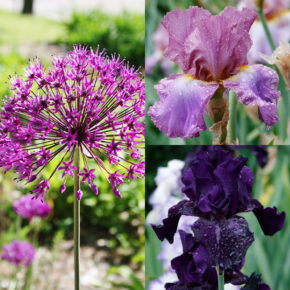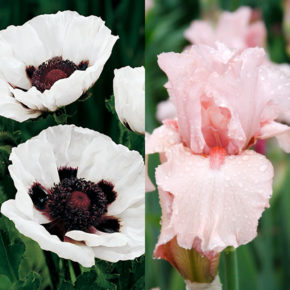Just like humans need companions to thrive, plants also need companions to thrive. Planting all of the same types of bush, tree or flower is no fun. Planting a limited selection of plants can also lead to problems if a disease or pest comes and wipes out that entire species. Therefore, when it comes to garden planning be sure to have companions for your plants for a diverse garden. Bearded Irises are an adored hardy perennial that combines well with other perennials and bulbs. When planning your bearded iris plantings be sure to mix in other perennials and bulbs as bearded iris companion plants.
Bearded Iris may already be a part of your garden and you want companion plants to make the space more diverse. Perhaps you don’t have bearded iris in your garden but want some late spring color from this colorful group of flowering perennials. If you enjoy bearded iris and want to make the most out of these late spring blooming perennials read more for suggestions on what to plant with bearded iris.
Plants that Bloom with Bearded Iris
Bearded Irises are late spring to early summer blooming perennials. Plant bearded iris in fall blooms in May or June depending on where you are located. To get the most of your planting area plant perennials and bulbs with similar bloom times to compliment the bearded iris in your garden.
Bearded Iris + Allium
Allium are popular fall-planted perennial bulbs that grow and bloom in spring. The combination of bearded iris and allium are the grand finale of the spring bulb flower season. They are the last of the fall-planted bulbs to bloom. Allium are generally available in purple, pink or white blooms. Bearded Iris are available in nearly every color of the rainbow. The color combinations of allium with bearded iris expansive.
Try combining Purple Sensation Allium with a selection of iris such as Anvil of Darkness Bearded Iris, Imbroglio Bearded Iris and Immortality Bearded Iris for a stunning display. The combination of purple allium and iris with the white Immortality Bearded Iris is a classic combination of rich contrasting colors.
Bearded Iris + Peonies
Peonies and Bearded Iris are colorful, showy, and put on a spectacular display in late spring. Peonies and Bearded Iris reach similar heights at maturity, generally in the 3-4’ range. However, the overall shape of the iris and peonies is much different.
Peonies have a shrub-like appearance with attractive foliage. While iris have an upright appearance with thick grassy leaves. Planting irises and peonies together creates a double impact with blooms appearing at the same time.
Depending on the variety of iris and peony you may want to plant the iris behind the peony so that the peony masks the foliage of the iris. If the variety of Iris you are planting grows shorter than the type of peony you are planting, you will need to plant the iris in front of the peony.
My favorite combination of peonies and bearded iris is one that represents the pastel colors often represented in the spring season. I like to plant light pink peonies like Eden’s Perfume Peony or Plena Rosa Peony with pastel blue iris such as Victoria Falls Bearded Iris. The combination of light pink peonies with light blue iris screams spring to me!
Bearded Iris + Oriental Poppies
This combination of late spring blooming perennials showcases different textures. The diversity in the mature height between the two plants makes them wonderful companions. Oriental Poppies are a bit lower to the ground compared to bearded iris so they should be planted in front of the bearded iris.
Poppy varieties like Harlem Oriental Poppy pair well with the light pink color of Lotus Land Bearded Iris. Perry’s White Oriental Poppy with its large white blooms complements any color of bearded iris. Both oriental poppies and bearded iris require soil that drains well. Similar growing conditions of well-drained soil and full sun make poppies and iris a match made in heaven!
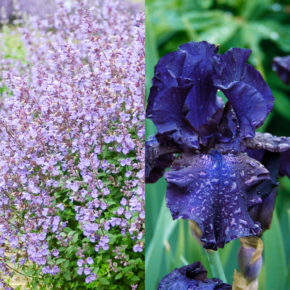 Bearded Iris + Catmint
Bearded Iris + Catmint
Catmint is a sprawling perennial with pale blue flowers. It begins to bloom at the same time as the bearded iris. Due to the sprawling habit of catmint, it helps to cover the foliage of the bearded iris. Compact varieties of catmint like Kitten Around Catmint only grow 12-14” tall. The short stature of Kitten Around Catmint makes it a perfect partner for tall blue iris such as Blueberry Bliss Bearded Iris or Stairway to Heaven Bearded Iris.
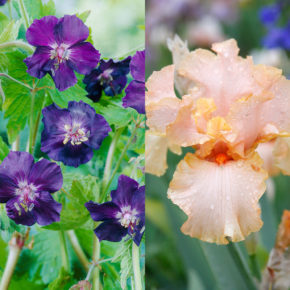 Bearded Iris + Cranesbill
Bearded Iris + Cranesbill
Cranesbill also known as hardy geranium has a sprawling habit that pairs well with bearded iris. Some varieties of cranesbill have a bloom season that begins in late spring and extends into summer. Most cranesbill will bloom heaviest in late spring to early summer which is the same time that bearded iris bloom. The low growing habit of cranesbill planted in front of the bearded iris makes for a delightful combination. The deep purple blooms of Raven Cranesbill look stunning planted with the peach blooms of Beverly Sills Bearded Iris.
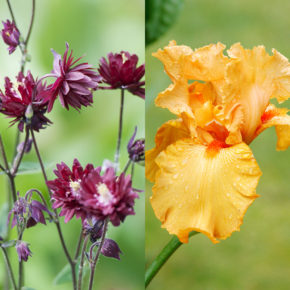 Bearded Iris + Columbine
Bearded Iris + Columbine
One of the more unique spring-blooming flowers are columbine. Having a much daintier appearance than bearded iris, the texture combines well with the iris. Columbine flowers begin blooming in mid to late spring. They serve as a lovely addition to the late spring garden.
Columbine can be planted in front of or surrounding the bearded iris. Their airy appearance, shorter height, and unique blooms will be noticeable in front of the iris foliage. Mixed Columbine are a classic spring favorite to combine with warm-colored bearded iris like War Chief Bearded Iris, Bold Look Bearded Iris, and Avalon Sunset Bearded Iris.
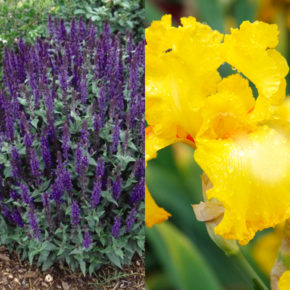 Bearded Iris + Salvia:
Bearded Iris + Salvia:
Salvia also known as Meadow Sage are some of my favorite perennials! I enjoy the vivid purple, pink and blue colors salvia blooms provide. In addition to the vivid colors, the long bloom time of salvia is appealing.
Salvia begins their bloom season in early summer which coincides with the end of the bearded iris bloom time. Salvia and Bearded Iris blooming together is a lovely transition from spring to summer. May Night Salvia is a popular variety, which is best planted in spring and matches well with yellow, purple, or white bearded iris.
Think of your Future Garden
For a well-balanced garden, it is important to plant perennials, shrubs, and trees that will have similar bloom times to your bearded iris. Also, consider your garden in the weeks and months that follow the bearded iris bloom season. Planting perennials that bloom in mid-to-late summer in the area your bearded iris helps to ensure color throughout the summer. In addition to adding color, this will help to balance the texture that bearded iris leaves have, as they can be a bit difficult to blend into the garden.
Planting perennials like daylilies that bloom later in the season will extend the color and interest in that area of the garden. In addition to extending the color and interest daylilies tend to be drought tolerant once established. The drought tolerance of daylilies compliment the bearded iris since they like soil that is on the dry side. Other perennials and bulbs that bloom later in the season that can be planted in the same garden area as your bearded iris are: Black-Eyed Susan, Coneflower, Oriental Lilies, Sedum, and Tall Garden Phlox.
Planning and planting your perennial garden is fun, exciting, and test of trial and error. Knowing where to start with companion plants is the first step to planning. I hope these ideas have inspired you to add to your bearded iris planting areas. Perhaps you will be inspired to start a new area in your garden with colorful bearded iris and perennials?
For bearded iris growing tips click here.


